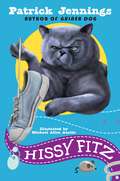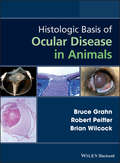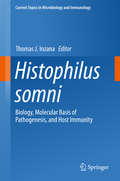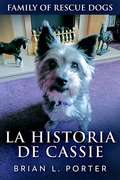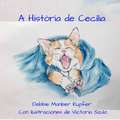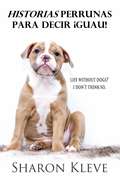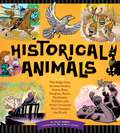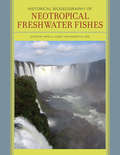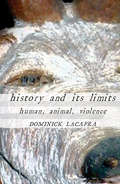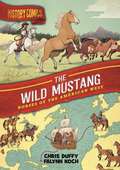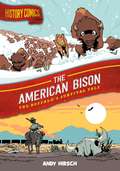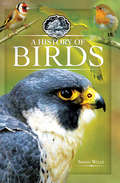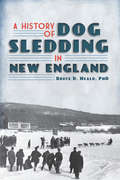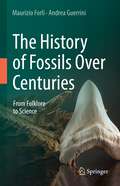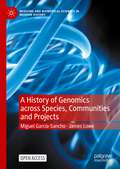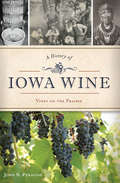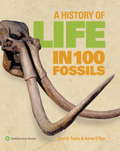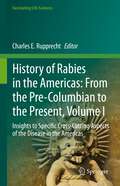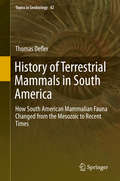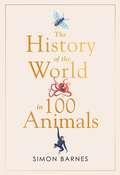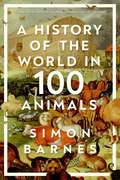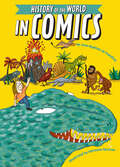- Table View
- List View
Hissy Fitz
by Patrick JenningsHissy Fitz lives with some two-legged creatures who are destined to serve him in every possible way and understand his every whim. Sadly, these creatures are sorely lacking in their skills. For one thing—they touch him when they want to touch him. Don't they know that the two-legged are there for him to touch when he wants to—meaning when he wants food? Petting wakes him up! They speak to him—don't they know the two-legged should be seen (so Hissy knows where to demand food from) and not heard?! It's becoming intolerable. What is this irascible cat to do?
Histoire de baleine
by Daniel S. Janik Catherine F.Cette histoire est sur les baleines à bosse du Pacifique. Bien qu'une fantaisie, elle contient néanmoins des informations intéressantes sur ces baleines qui migrent chaque année d'Hawaï vers l'Alaska, et vice-versa.
Histologic Basis of Ocular Disease in Animals
by Bruce Grahn Robert Peiffer Brian WilcockHistologic Basis of Ocular Disease in Animals is a comprehensive reference covering pathology of the eye in a spectrum of animal species, including domestic animals, fish, birds, and laboratory animals. Offers a comprehensive resource on diseases and conditions of the eye and orbit in a wide range of species Covers domestic animals, fish, birds, and laboratory animals Presents more than 1200 high-quality images carefully selected to illustrate the ocular conditions covered Emphasizes unique pathological responses where necessary
Histophilus somni
by Thomas J. InzanaThis volume reviews the current understanding of the taxonomy, disease syndromes, genetics, biology, and pathogenic factors of Histophilus somni, as well as the host immune response to this pathogen. H. somni is one of the most important bacterial pathogens in cattle and other ruminants, and its virulence factors are highly conserved with Haemophilus influenzae and other members of the Pasteurellaceae. H. somni has been recognized as a major cause of thrombotic meningoencephalitis, respiratory disease syndromes, myocarditis, reproductive disease syndromes, polyarthritis, mastitis, ocular disease, and septicemia. The only known habitats of H. somni are the mucosal surfaces of ruminants, making this bacterium an opportunistic pathogen. Although it is capable of causing inflammation at systemic sites and is toxic to epithelial and phagocytic cells, the bacterium's wide array of virulence factors act primarily as a defense against, or to escape recognition from, host innate and adaptive immunity.
La historia de Cassie
by Brian L. PorterEsta es la historia de Cassie: una perrita de rescate que tenía poco más de dos años cuando se unió a la familia de rescates de Brian y Juliet, habiendo tenido ya tres dueños anteriores en su corta vida. La pequeña terrier pronto se abrió camino en los corazones de la familia, y sus payasadas y su actitud sobredimensionada le valieron rápidamente los apodos de'El hurón loco' y'La bruja malvada del Oeste'. Cassie puede describirse mejor como una 'dinamo de bolsillo' o, como dice el autor, "está llena de energía ilimitada y, a pesar de tener catorce años, es como un conejito de Duracell sin interruptor de apagado". Cassie se ha recuperado de las operaciones, se las arregló para perderse y fue encontrada en una tarde, ahuyentó a los Rottweilers y Dobermans que han tenido el valor de intentar robar su pelota de tenis, y se encontró a sí misma lesionada por interferir en las peleas de perros más grandes. La gente no puede evitar enamorarse de este pequeño bulto de alegría.
A História de Cecília
by Debbie Manber Kupfer Sueli AstriniCecília está em busca de um novo humano, mas será que ela o encontrará ? Disseram que eles eram muito difíceis de treinar. Da autora de P.A.W.S. e Esmeralda Grunch and the Red Tulip.
La historia de Kali: Rescate de un oso polar huérfano (¡Arriba la Lectura!, Read Aloud Module 9 #2)
by Jennifer Curtis John GomesNIMAC-sourced textbook
Historias Perrunas para decir ¡Guau!
by Sharon KleveHistorias Perrunas para decir ¡Guau! está lleno de tentadoras trivialidades y curiosidades, juegos de palabras y muchos datos sobre cachorros; esta dogo-pedia es una lectura esencial para cualquier amante de los perros. Aprenderás cosas sobre diferentes tipos de perros, razas, personajes... ¡y mucho más! Es un hermoso libro de sobremesa repleto de asombrosas fotografías y divertidos datos; los dueños de perros y fanáticos podrán examinar en profundidad a estos adorables y curiosos amigos de cuatro patas. Levanta las patas si amas todo lo relacionado con los perros, desde su alegría incontenible hasta su lengua babosa.
Historical Animals: The Dogs, Cats, Horses, Snakes, Goats, Rats, Dragons, Bears, Elephants, Rabbits and Other Creatures that Changed the World
by Julia MobergThroughout history, animals have shaped the world as we know it. But rarely have they received the recognition they deserve. Until now.This inside look at history’s most famous animals features wacky verse, cool facts, historical stats, and zany cartoon art. Meet Alexander the Great’s horse Bucephalus, who was his battle companion for nearly 30 years. Learn about Mozart’s starling bird that helped him write music by singing along as he composed. Read about the Ethiopian goats that discovered the coffee bean, Marco Polo seeing dragons in China, and a dog named Boatswain that saved Napoleon’s life. From the cobra that killed Cleopatra to Cairo, the dog that helped hunt down Osama bin Laden, Historical Animals has these stories and more!
Historical Biogeography of Neotropical Freshwater Fishes
by James S. Albert Roberto E. ReisThe fish faunas of continental South and Central America constitute one of the greatest concentrations of aquatic diversity on Earth, consisting of about 10 percent of all living vertebrate species. Historical Biogeography of Neotropical Freshwater Fishes explores the evolutionary origins of this unique ecosystem. The chapters address central themes in the study of tropical biodiversity: why is the Amazon basin home to so many distinct evolutionary lineages? What roles do ecological specialization, speciation, and extinction play in the formation of regional assemblages? How do dispersal barriers contribute to isolation and diversification? Focusing on whole faunas rather than individual taxonomic groups, this volume shows that the area's high regional diversity is not the result of recent diversification in lowland tropical rainforests. Rather, it is the product of species accumulating over tens of millions of years and across a continental arena.
History and Its Limits: Human, Animal, Violence
by Dominick LacapraDominick LaCapra's History and Its Limits articulates the relations among intellectual history, cultural history, and critical theory, examining the recent rise of "Practice Theory" and probing the limitations of prevalent forms of humanism. LaCapra focuses on the problem of understanding extreme cases, specifically events and experiences involving violence and victimization. He asks how historians treat and are simultaneously implicated in the traumatic processes they attempt to represent. In addressing these questions, he also investigates violence's impact on various types of writing and establishes a distinctive role for critical theory in the face of an insufficiently discriminating aesthetic of the sublime (often unreflectively amalgamated with the uncanny). In History and Its Limits, LaCapra inquires into the related phenomenon of a turn to the "postsecular," even the messianic or the miraculous, in recent theoretical discussions of extreme events by such prominent figures as Giorgio Agamben, Eric L. Santner, and Slavoj Zizek. In a related vein, he discusses Martin Heidegger's evocative, if not enchanting, understanding of "The Origin of the Work of Art." LaCapra subjects to critical scrutiny the sometimes internally divided way in which violence has been valorized in sacrificial, regenerative, or redemptive terms by a series of important modern intellectuals on both the far right and the far left, including Georges Sorel, the early Walter Benjamin, Georges Bataille, Frantz Fanon, and Ernst Jünger. Violence and victimization are prominent in the relation between the human and the animal. LaCapra questions prevalent anthropocentrism (evident even in theorists of the "posthuman") and the long-standing quest for a decisive criterion separating or dividing the human from the animal. LaCapra regards this attempt to fix the difference as misguided and potentially dangerous because it renders insufficiently problematic the manner in which humans treat other animals and interact with the environment. In raising the issue of desirable transformations in modernity, History and Its Limits examines the legitimacy of normative limits necessary for life in common and explores the disconcerting role of transgressive initiatives beyond limits (including limits blocking the recognition that humans are themselves animals).
History Comics: Horses of the American West (History Comics)
by Chris DuffyAn American Library Association 2021 Best Graphic Novel for ChildrenTurn back the clock with History Comics, First Second's new nonfiction graphic novel series! In this volume, learn how wild mustangs were first introduced to America and how they still roam free today.On the North American plains, wild mustangs have roamed for generations . . . shaping human history and struggling to survive it. For the Spanish, they were a tool of conquest. For Native Americans, they brought on a new way of life where horsemanship and horse-trading were central. And for the entire world, wild mustangs became a renowned wonder of the American West. There are still thousands of mustangs in the wild today, but they struggle to survive in an ever-changing landscape and their future is by no means guaranteed.
History Comics: The Buffalo's Survival Tale (History Comics)
by Andy HirschAn American Library Association 2021 Best Graphic Novel for ChildrenTurn back the clock with History Comics, First Second's new nonfiction graphic novel series! In this volume, learn how millions of buffalo once roamed the American prairie—until they were nearly driven to extinction.In the early 18th century the American prairies shook under the hooves of nearly 30 million bison. Fast as a horse, tall as a person, and heavier than both combined, they roamed from coast to coast. A century later, people struggled to find a single one left alive. How did the great herds disappear, and what will it take to bring them back?
A History of Birds
by Simon Wills“Intriguing stories from the history of the human relationship with birds, including their symbolism in art, literature, religion, and folklore” (Booklist). Even the most well-informed wildlife enthusiast will be entertained by the stories and fascinating facts in this beautifully illustrated book. Our ancestors hunted, tamed, worshipped, and depicted birds, and even bestowed magical properties upon them. Why did ancient writers consider the sparrow a lustful creature? Which bird was killed and hung up to predict the weather? And what was an “arse-foot?” Wildlife photographer and history journalist Simon Wills explores the intriguing and at times bizarre stories behind our relationship with birds. Find out why robins feature on Christmas cards, and how Mozart was persuaded to keep a pet starling. What bird did Florence Nightingale carry around in her pocket? How did the blue tit get its name? Whole careers have been created around birds—from falconers to ostrich farmers—and birds have had great symbolic importance too. Discover, for example, why Raleigh bicycles carry a heron logo and why church lecterns are in the shape of an eagle. If you enjoy wildlife, then this book is full of surprises. Pigeons were trained to carry messages in wartime, but could gulls be taught to hunt U-boats? And which American president’s parrot started swearing at his funeral? “A pleasing and often illuminating book with many examples of historical connections with birds, from Queen Victoria’s parrots and the Prince of Wales’s feathers to Kellogg’s cockerel and recipes for flamingos.” —Bird Watch
The History of Bourbon King 1788
by W. Jefferson HarrisThis is a thorough history of Bourbon King, one of the most influential Saddlebred sires of the early 20th century. Covers his show and breeding careers, as well as biographies of his famous ancestors and get.
A History of Dog Sledding in New England (Sports)
by Bruce D. HealdSled dogs trot through expanses of sparkling white snow, pulling a musher and energetically surging with the command, "Let's go!" From puppies to seasoned competitors, sled dogs partner with mushers in a passionate pursuit of a great racing tradition. The renowned and formidable Laconia World Championship Sled Dog Derby, the New England Sled Dog Club and famous drivers like Dr. Charles Belford--who came in fifth place at Laconia at the age of seventeen--helped solidify the fame of New England sled dog trails. Historian Bruce D. Heald celebrates the best of the sport in the region, from the feats of legendary Arthur Walden and his famous Chinook dogs to the Siberian huskies' contribution to the World War II effort. Join Heald as he charts the legacy of this remarkable sport.
The History of Fossils Over Centuries: From Folklore to Science
by Maurizio Forli Andrea GuerriniThis book discusses the history of invertebrate fossil understanding and classification by exploring fossil studies between the 15th and 18th centuries. Before the modern age, the understanding of fossil findings went through several phases. The treatment by philologists, philosophers and historians of natural sciences involved religious, sometimes folkloristic, aspects before scientific ones. This work showcases and assesses these original findings by carrying out a bibliographical, and above all iconographical research, aimed at finding the first printed images of the objects that we now know as fossils. From here, the authors provide an understanding of the true nature of fossils by analyzing them through modern academic viewpoints, and describing each fossil group from a paleontological and taxonomic point of view, retracing their treatment in the course of the centuries.As a point of reference for each fossil group treated, the authors have considered indispensable the use of ancient prints as evidence of the first iconographic sources dedicated to fossils, starting from those in the late fifteenth century, dedicated to the most common groups of invertebrates without neglecting a necessary exception, the ichthyodontolites, fundamental in the discussion in Italy on the interpretation of the organic origin of fossils, and from the end of the sixteenth century to about half of the eighteenth century. The abundant iconographic apparatus used, often unpublished or specially reworked, is essential and functional to the understanding of the various aspects addressed, a visual complement to the text and vice versa, designed and used taking its cue from the need imposed on early scholars to document their discoveries visually. Among the chosen images there is no shortage of original attributions to fossil finds that have been poorly understood or misidentified until now.The English translation of this book from its Italian original manuscript was done with the help of artificial intelligence (machine translation by the service provider DeepL.com). A subsequent human revision of the content was done by the authors.
A History of Genomics across Species, Communities and Projects (Medicine and Biomedical Sciences in Modern History)
by Miguel García-Sancho James LoweThis open access book offers a comprehensive overview of the history of genomics across three different species and four decades, from the 1980s to the recent past. It takes an inclusive approach in order to capture not only the international initiatives to map and sequence the genomes of various organisms, but also the work of smaller-scale institutions engaged in the mapping and sequencing of yeast, human and pig DNA. In doing so, the authors expand the historiographical lens of genomics from a focus on large-scale projects to other forms of organisation. They show how practices such as genome mapping, sequence assembly and annotation are as essential as DNA sequencing in the history of genomics, and argue that existing depictions of genomics are too closely associated with the Human Genome Project. Exploring the use of genomic tools by biochemists, cell biologists, and medical and agriculturally-oriented geneticists, this book portrays the history of genomics as inseparably entangled with the day-to-day practices and objectives of these communities. The authors also uncover often forgotten actors such as the European Commission, a crucial funder and forger of collaborative networks undertaking genomic projects. In examining historical trajectories across species, communities and projects, the book provides new insights on genomics, its dramatic expansion during the late twentieth-century and its developments in the twenty-first century. Offering the first extensive critical examination of the nature and historicity of reference genomes, this book demonstrates how their affordances and limitations are shaped by the involvement or absence of particular communities in their production.
A History of Iowa Wine: Vines on the Prairie (American Palate)
by John N. PeragineIowa has a history with grapevines that goes back more than a century. New York lawyer Hiram Barney obtained a tract of land in southeast Iowa as part of the Half-Breed program following the American Indian Wars and created the White Elk Winery. German settlers in Amana tended community vineyards for communal wines. Before Prohibition, the Council Bluffs Grape Growers Association grew grapes and shipped them eastward by the ton. In the early 1900s, the state was among the nation's top producers of grapes. Pesticides, weather and government subsidies ended the time of the vines of the prairie until their recent return. Author John N. Peragine details the rise, fall and resurgence of the industry in the Hawkeye State.
A History of Life in 100 Fossils
by Paul D. Taylor Aaron O'DeaA History of Life in 100 Fossils showcases 100 key fossils that together illustrate the evolution of life on earth. Iconic specimens have been selected from the renowned collections of the two premier natural history museums in the world, the Smithsonian Institution, Washington, and the Natural History Museum, London. The fossils ahve been chosen not only for their importance in the history of life, but also because of the visual story they tell. This stunning book is perfect for all readers because its clear explanations and beautiful photographs illuminate the significance of these amazing pieces, including 500 million-year-old Burgess Shale fossils that provide a window into early animal life in the sea, insects encapsulated by amber, the first fossil bird Archaeopteryx, and the remains of our own ancestors.
History of Rabies in the Americas: Insights to Specific Cross-Cutting Aspects of the Disease in the Americas (Fascinating Life Sciences)
by Charles E. RupprechtRabies is one of the oldest known pathogens, is incurable, and has the highest fatality rate of all infectious diseases. The Americas is the only region with bat rabies virus, including vampire bat rabies. The region is rich in cultural references and notable for many discoveries in the field, including the current vaccine potency test, diagnostic assay, conception of oral vaccines for wildlife, the first human survivor and the first successful canine rabies program executed at a broad level. Rabies remains the most important viral zoonosis, with tens of thousands of human fatalities and tens of millions of exposures annually, which can be used to model for other pathogens, such as COVID-19. There is an international effort to eliminate human rabies caused by dogs over the next decade, and the Americas represent the primary region with the greatest proof-of-concept evidence to accomplish this goal. This two-volume set addresses the medical history and modern results of rabies in countries throughout the Americas, including the implications of and on cultural, economic, sociological, and research developments in the region. Volume I presents an overview of concepts critical to the study of rabies in the region, including evolutionary aspects, reservoir ecology and control, elimination efforts, vaccine development, and disease hallmarks and progression. It also analyzes the long-term cultural, social, and economic impacts of the disease in the Americas.
History of Terrestrial Mammals in South America: How South American Mammalian Fauna Changed From The Mesozoic To Recent Times (Topics in Geobiology #42)
by Thomas DeflerThis book takes a non-technical approach in covering the evolution of South American mammalian fauna throughout geological history, and discusses how South America has changed due to mammalian invasions. Unlike other works on the subject, this book attempts to answer several crucial questions that often go unmentioned together in one cohesive monograph. What was the fauna like before the American interchange? What were the origins of the now-extinct groups when northern species arrived and out-competed them? How did the modern mammalian fauna come into being with such disparate animal groups? This information is given from a historical perspective throughout the book's 15 chapters, and is presented in an easily graspable fashion by mostly avoiding technical language. The book is written for academics, scientists and scholars engaged in paleontology, zoology and evolutionary biology, but may also appeal to a larger audience of general readers interested in mammalian evolution. The book begins with an introduction, describing the tools necessary to interpret the evolutionary history of South American mammals in geological terms and some of the early people who helped found South American mammalian paleontology. Chapter 2 describes the Mesozoic first mammals of Gondwana and what we are learning about them, dominant before the K/T extinction event. Then chapters 3 through 8 cover the Cenozoic, or "Age of Mammals", highlighting the major mammalian groups of South America that replaced the earlier mammals of Gondwana. These groups include the marsupials, native ungulates, the xenarthrans (armadillos, anteaters, sloths), the caviomorphs (rodents), and the platyrrhine monkeys. Chapters 9 and 10 address the Antarctic La Meseta fossils and the Colombian La Venta fossil faunal assemblages. Chapter 11 discusses the neotropical mammals that invaded the Caribbean Islands, and illustrates the influence South America has had on adjacent faunas. Chapter 12 describes the origin of the Amazon River and the role it has played in the evolution of the mammals and other flora and fauna. Chapter 13 tells the story of the Great American Biotic Interchange (GABI), and chapter 14 follows this up with a discussion of the Pleistocene mammal communities and their eventual extinction. Chapter 15 concludes the text by discussing the modern mammals of South America, and how despite the extensive Pleistocene extinctions there is still a lot of mammalian diversity in South America.
History of the World in 100 Animals
by Simon BarnesA powerful and fascinating insight into the 100 animals - from the blue whale to the mosquito - that have had the biggest influence on humanity through the ages. We are not alone. We are not alone on the planet. We are not alone in the countryside. We are not alone in cities. We are not alone in our homes. We are humans and we love the idea of our uniqueness. But the fact is that we humans are as much members of the animal kingdom as the cats and dogs we surround ourselves with, the cows and the fish we eat, and the bees who pollinate so many of our food-plants. In The History of the World in 100 Animals, award-winning author Simon Barnes selects the 100 animals who have had the greatest impact on humanity and on whom humanity has had the greatest effect. He shows how we have domesticated animals for food and for transport, and how animals powered agriculture, making civilisation possible. A species of flea came close to destroying human civilisation in Europe, while the slaughter of a species of bovines was used to create one civilisation and destroy another. He explains how pigeons made possible the biggest single breakthrough in the history of human thought. In short, he charts the close relationship between humans and animals, finding examples from around the planet that bring the story of life on earth vividly to life, with great insight and understanding. The heresy of human uniqueness has led us across the millennia along the path of destruction. This book, beautifully illustrated throughout, helps us to understand our place in the world better, so that we might do a better job of looking after it. That might save the polar bears, the modern emblem of impending loss and destruction. It might even save ourselves.
A History of the World in 100 Animals
by Simon BarnesFully illustrated in color, a fascinating exploration of the one hundred animals that have had the most profound influence on humanity throughout the ages.We are not alone. We are not alone on the planet. We are not alone in the countryside. We are not alone in cities. We are not alone in our homes. We are humans and we love the idea of our uniqueness. But the fact is that we humans are as much members of the animal kingdom as the cats and dogs we surround ourselves with, the cows and the fish we eat, and the bees who pollinate so many of our food-plants. In The History of the World in 100 Animals, award-winning author Simon Barnes selects the one hundred animals who have had the greatest impact on humanity and on whom humanity has had the greatest effect. He shows how we have domesticated animals for food and for transport, and how animals powered agriculture, making civilisation possible. A species of flea came close to destroying human civilisation in Europe, while the slaughter of a species of bovines was used to create one civilisation and destroy another. He explains how pigeons made possible the biggest single breakthrough in the history of human thought. In short, he charts the close relationship between humans and animals, finding examples from around the planet that bring the story of life on earth vividly to life, with great insight and understanding. The heresy of human uniqueness has led us across the millennia along the path of destruction. This book, beautifully illustrated throughout, helps us to understand our place in the world better, so that we might do a better job of looking after it. That might save the polar bears, the modern emblem of impending loss and destruction. It might even save ourselves.
The History of the World in Comics
by Jean-Baptiste de PanafieuNever has natural history been so fun! Scientific accuracy and humor combine to tell the entire history of Earth in a comic book format.A paleontologist and a storyteller take two children through the birth of our planet, the beginning of microbes, and through the heydays of protozoans, dinosaurs, and early mammals with unfailing enthusiasm. The art accurately portrays animal species and prehistoric landscapes, includes maps and infographics, but also adds humorous touches: a google-eyed prehistoric fish looking startled to be walking on land and the children popping out of a tree top to surprise a Brachiosaurus. The combined expertise of author Jean-Baptiste de Panafieu, a science writer and biologist, and illustrator Adriene Barman, the creator behind Creaturepedia and Plantopedia, makes for a science read you can trust. Fans of Maris Wicks's Human Body Theater and Nathan Hale will be pleased.
